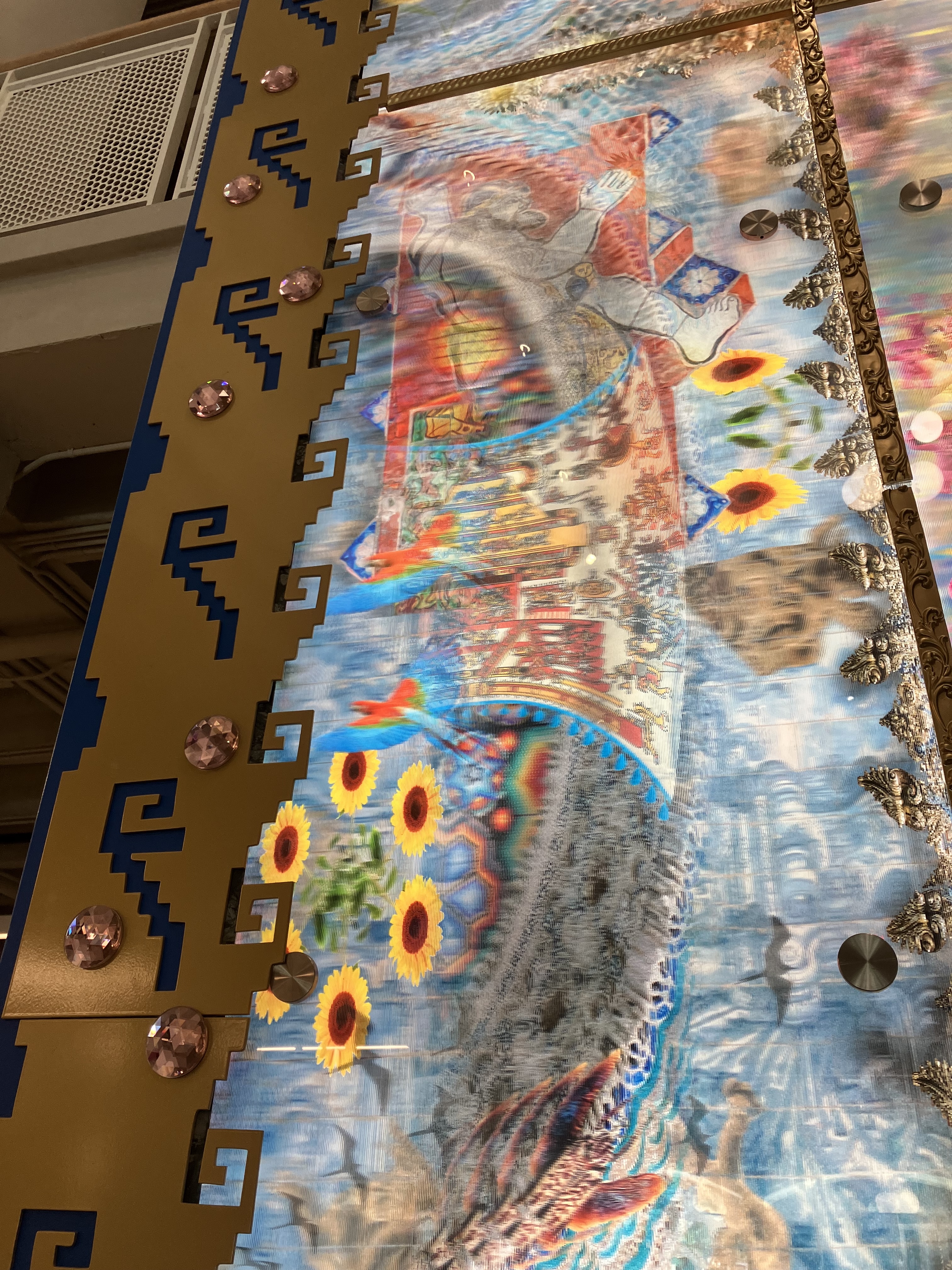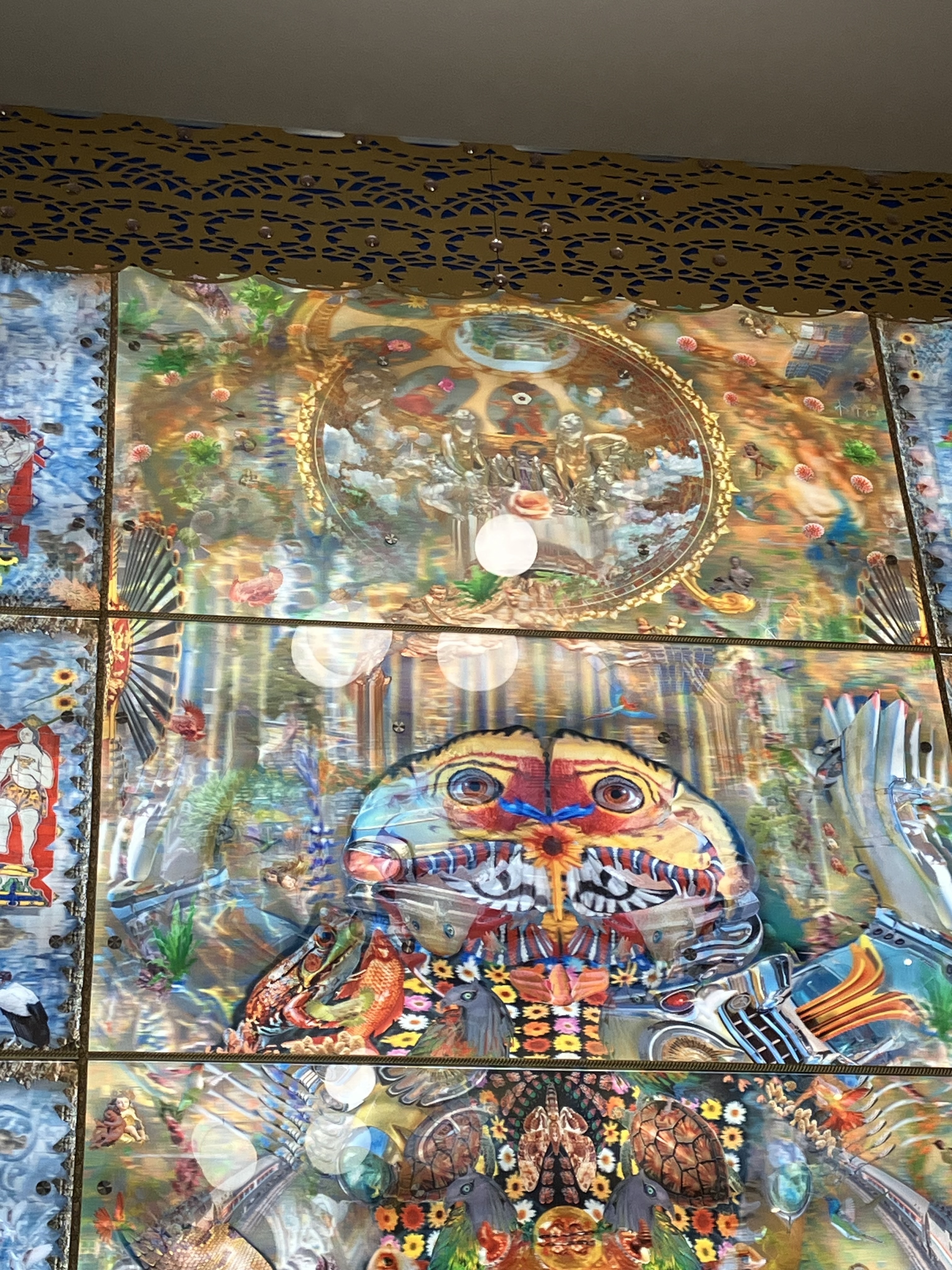Gaiatlicue (2022) is a two-story, backlit lenticular photomontage that lives at the Cheech Marin Center for Chicano Art & Culture of the Riverside Art Museum (better known as ‘The Cheech’). As one enters the museum, the various images forming the collage of Gaiatlicue become clear and obscure from various perspectives depending on where the viewer is in the museum in relation to the image. The name of this piece is a portmanteau of Gaia, an earth goddess and mother of all life in Greek mythology, and Coatlicue, the Aztec earth deity who, according to legend, was mother to Huitzlipochtli.1 Through the use of a lenticular collage—a process that combines two images by cutting them into thin vertical segments, interlacing one with the other and placing them behind a plastic prism—this homage presents both these deities. Gaiatlicue floats or stands at the center of this panel. In its dual form, one image of her represents the natural world, and the other portrays the world of technology.2 Its hallucinatory presence greets (or haunts) visitors as soon as they enter the museum doors. In contrast to the National Anthropology Museum in Mexico City, whose curation of the Mexica Hall is anchored to the Piedra de Sol, Gaiatlicue in The Cheech is an omnipresent and omniscient figure that towers over the museum’s galleries.
Einar and Jamex de la Torre, Gaiatlicue (2022)
This focal piece of The Cheech, Gaiatlicue, was designed by brothers Einar and Jamex de la Torre and commissioned by the Riverside Art Museum for the opening of the new center in 2022. The de la Torre brothers have collaborated artistically since the 1990s; they have attributed their inspirations to pre-Columbian iconography, German expressionism, and Baroque architecture.3 As a result, their colorful work, which is multi-layered, multi-component, and oftentimes mixed media, is loud and renders them indexes of a world of their own making. In this manner, their work utilizes a rasquache aesthetic that comprises a mash-up of religious images, pop culture, and current events.4 Following the bi-cultural sensibility, the de la Torre brothers seem to use the garish as a means for irony to address pertinent topics such as immigration, nationalism, and identity, among others.
By invoking the earth goddesses whose names comprise the work’s title, Gaiatlicue suggests that these are all manifestations of the singular planet on which we all reside. In this kaleidoscope-like collage, the de la Torre brothers captivate their audiences with an urgent matter that affects us all—climate change. The technique of creating a photomontage gives shape to the Gaiatlicue and gives the impression that you are seeing a statue that moves as you navigate the museum space. Further, it reveals the ever-shifting multitude of superimposed images and endows Gaiatlicue with a personified living presence. Moreover, this effect is a reminder of the urgency of her subject matter. The lenticular collage portrays fleeting images which serve as a metaphor for the ephemerality and mutability of the natural world, but can be aided by technological inventions.
In one view, Gaiatlicue’s body is composed of flora and fauna, and is surrounded by earthly visuals derived from the natural world. She stands with her arms resting at her hips like an impatient mother. Rather than two snakes emerging from her body, moth wings, snakes, and a flower recreate the symmetrically formed face. Slightly above her head, on her left (the viewer’s right) a hummingbird takes flight—a reference to the name of Huitzilopochtli, which translates to "hummingbird" and "left" in English. With careful detail one notices the elements of nature that comprise this enormous body: frogs and fishes are at her shoulders, tortoise feet are her forearms, and birds seem like curled fingers at her sides. Her torso is made of rows of flowers, and at the center resembling a pair of lungs is a butterfly or moth (a possible allusion to the goddess Itzpapalotl, or “Obsidian Butterfly”). Her infamous necklace is made of tortoise shells, feathers, and birds. At the center of this necklace is a crowned head that looks like many of the de la Torre glass sculptures. A snake is a belt for her skirt made of verdant matter. At her feet, toucan beaks are in place of claws. The background, from which she emerges in one-point perspective, appears to be the site of a church or religious institution (given the trefoil arches). Superimposed over this architectural design are scenes of palm trees, maguey plants, and other foliage. Standing behind her, and seemingly tiny in comparison to her monumental stature, are purple pre-Columbian clay figurines. Below her is a blue globe with a map of the U.S.-Mexico border at the center, and above her is a gold dome that resembles a halo or sun. In religious art, the golden halo around a figure’s head has signified they are a holy or sacred individual. Her image is bordered by a series of panels with oval cartouches that are decorated with Huichol chaquira designs of flowers and pages from the sixteenth-century Codex Borgia. In this version, she wields the power of natural elements found on the earth, in art, and Indigenous knowledge.
In the other view of Gaiatlicue, she is made of lowrider parts. Her whole body is constituted of photographs that the de la Torre brothers captured in Chicano Park in San Diego, California.5 As a nod to car culture and car clubs in Southern California, her head combines two vintage cars facing each other, and the front-view of a car. Throughout California, Mexican American youths have participated in car clubs since the late 1940s, which has contributed to place-making and identity formation. Therefore, these images are particularly emblematic of cultural specificity and a history unique to the region. Her shoulders have a pinstriping or rótulo design found on low-riders that resemble burning flames. Her arms are raised above her head and look like blades. A hummingbird flies by her right hand (the viewer’s left). Giving her a sort of tentacular form, Amtrak trains emerge from her sides. Her torso is made of the front grill of a gold Chevrolet. Her necklace is made of alternating gold and silver hubcaps shaped in the form of hands and hearts. Noticeably missing is her skirt, and this version of Gaiatlicue is given separate legs that are made of images of cars. Rather than have two strands that tie her skirt, she has a single cord that falls between her legs. Below her feet is a blue-gray globe that resembles the moon, and above her head is a gold wreath with celestial images. The background is a map that shows the web of freeways that connect East Los Angeles and Riverside (the location of the museum). East Los Angeles has historically been an immigrant neighborhood, but in the last century it has been known specifically as a Mexican and Central American enclave. Riverside has now become the second home to these latter generations of Mexican and Central Americans. By including maps in their design, the brothers make an intimate connection between place and identity. Interspersed on this plane are recognizable sites of downtown Riverside and solar panels. Atop this layer is a braid of plants native to California. A panel of Talavera frames the Gaiatlicue. While the use of lowriders in this version is one that celebrates this tradition, it also represents a harmful antithesis to the potential for public transport and solar powered energy, and thus reflects a tension between cultural tradition and the pressing need for ecological consciousness. This version of her exhibits industry and represents the potential generative qualities that science can yield.
Gaiatlicue taps into both the natural and technological worlds, which in the de la Torre brothers’ inventiveness can work together in a fight against climate change. Resonating with the current state of the environmental crisis, her form is emblematic of her ‘give and take’ dynamic.6 As the viewer on the ground floor examines the lenticular photomontage, various images are presented as one moves laterally. Juxtaposed with the monument, the de la Torres’ version is heavily complex with added layers of metaphors and, similar to the original, is quite difficult to read and demands one’s attention. In the recreation, she is both the creator of these worlds, as well as the mediator between them. As a feminine force, she typifies both the ‘good’ and ‘bad,’ qualities that we can never quite locate in the original Coatlicue. Here, the de la Torre brothers instantiate these deities to highlight the need to bridge these seemingly two distinct entities of the natural and the technological. Gaitlicue demonstrates our futures depend on these two worlds coexisting and sustaining one another.
-----------------------------------------------------------------------------
1. Fray Diego Durán, The History of the Indies of New Spain, trans. Doris Heyden (Norman: University of Oklahoma Press, 1994), 215.↩
2. “Cheech Marin reveals the first art going into The Cheech Marin Center for Chicano Art & Culture,” YouTube, 11 May 2022: https://www.youtube.com/watch?v=poA-r7f8pck.↩
3. “About”, De La Torre Brothers: https://www.delatorrebrothers.art/about.↩
4. ‘Rasquache’ has been theorized in Tomás Ybarra-Frausto’s influential text, Rasquachismo: A Chicano Sensibility (School by the River Press, 1989).↩
5. Ruben C. Cordova, “‘The Cheech’ Center for Chicano Art is Brilliantly Inaugurated by the de la Torre Brothers’ ‘Collidoscope’” Glasstire (2023): https://glasstire.com/2023/06/07/the-cheech-center-for-chicano-art-is-brilliantly-inaugurated-by-the-de-la-torre-brothers-collidoscope/.↩
6. Museum label for Einar and Jamex de la Torre (2022), Gaiatlicue [Lenticular], Riverside, CA: Riverside Art Museum.↩





